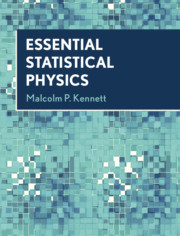Refine search
Actions for selected content:
31 results
10 - Neural Diffusion Models, I. Network and Dynamical System Models
-
- Book:
- Diffusion Process Models of Decision Making
- Published online:
- 26 October 2025
- Print publication:
- 13 November 2025, pp 255-286
-
- Chapter
- Export citation
7 - Introduction to the Thermodynamical and Statistical Descriptions of Phase Transitions
-
- Book:
- Statistical Mechanics for Physicists and Mathematicians
- Published online:
- 28 July 2025
- Print publication:
- 14 August 2025, pp 261-287
-
- Chapter
- Export citation
11 - Numerical Simulations
-
- Book:
- Probability Theory for Quantitative Scientists
- Published online:
- 24 July 2025
- Print publication:
- 14 August 2025, pp 289-303
-
- Chapter
- Export citation
1 - Condensed matter physics
- from Part I - Areas of application
-
- Book:
- Quantum Algorithms
- Published online:
- 03 May 2025
- Print publication:
- 24 April 2025, pp 4-28
-
- Chapter
-
- You have access
- Open access
- Export citation
A Note on Ising Network Analysis with Missing Data
-
- Journal:
- Psychometrika / Volume 89 / Issue 4 / December 2024
- Published online by Cambridge University Press:
- 01 January 2025, pp. 1186-1202
-
- Article
-
- You have access
- Open access
- HTML
- Export citation
Objective Bayesian Edge Screening and Structure Selection for Ising Networks
-
- Journal:
- Psychometrika / Volume 87 / Issue 1 / March 2022
- Published online by Cambridge University Press:
- 01 January 2025, pp. 47-82
-
- Article
-
- You have access
- Open access
- HTML
- Export citation
Robust Measurement via A Fused Latent and Graphical Item Response Theory Model
-
- Journal:
- Psychometrika / Volume 83 / Issue 3 / September 2018
- Published online by Cambridge University Press:
- 01 January 2025, pp. 538-562
-
- Article
- Export citation
1 - Introduction
-
- Book:
- Modern Discrete Probability
- Published online:
- 14 December 2023
- Print publication:
- 18 January 2024, pp 1-20
-
- Chapter
-
- You have access
- Export citation
6 - The Mean-Field Approach
-
- Book:
- A Student's Guide to the Ising Model
- Published online:
- 11 May 2023
- Print publication:
- 25 May 2023, pp 150-173
-
- Chapter
- Export citation
3 - Partial Summations and Effective Interactions
-
- Book:
- A Student's Guide to the Ising Model
- Published online:
- 11 May 2023
- Print publication:
- 25 May 2023, pp 65-93
-
- Chapter
- Export citation
5 - The Onsager Solution and Exact Series Expansions
-
- Book:
- A Student's Guide to the Ising Model
- Published online:
- 11 May 2023
- Print publication:
- 25 May 2023, pp 125-149
-
- Chapter
- Export citation
4 - Infinite Ising Systems in One Dimension
-
- Book:
- A Student's Guide to the Ising Model
- Published online:
- 11 May 2023
- Print publication:
- 25 May 2023, pp 94-124
-
- Chapter
- Export citation
7 - Position-Space Renormalization-Group Techniques
-
- Book:
- A Student's Guide to the Ising Model
- Published online:
- 11 May 2023
- Print publication:
- 25 May 2023, pp 174-210
-
- Chapter
- Export citation
2 - Finite Ising Systems
-
- Book:
- A Student's Guide to the Ising Model
- Published online:
- 11 May 2023
- Print publication:
- 25 May 2023, pp 29-64
-
- Chapter
- Export citation
1 - The Ising Model
-
- Book:
- A Student's Guide to the Ising Model
- Published online:
- 11 May 2023
- Print publication:
- 25 May 2023, pp 1-28
-
- Chapter
- Export citation

A Student's Guide to the Ising Model
-
- Published online:
- 11 May 2023
- Print publication:
- 25 May 2023
-
- Textbook
- Export citation
6 - Monte Carlo Applications
-
- Book:
- Programming in Parallel with CUDA
- Published online:
- 04 May 2022
- Print publication:
- 02 June 2022, pp 178-208
-
- Chapter
- Export citation
Conditional mean risk sharing in the individual model with graphical dependencies
-
- Journal:
- Annals of Actuarial Science / Volume 16 / Issue 1 / March 2022
- Published online by Cambridge University Press:
- 17 June 2021, pp. 183-209
-
- Article
- Export citation
Lee-Yang zeros of the antiferromagnetic Ising model
- Part of
-
- Journal:
- Ergodic Theory and Dynamical Systems / Volume 42 / Issue 7 / July 2022
- Published online by Cambridge University Press:
- 08 April 2021, pp. 2172-2206
- Print publication:
- July 2022
-
- Article
-
- You have access
- Open access
- Export citation

Essential Statistical Physics
-
- Published online:
- 29 August 2020
- Print publication:
- 16 July 2020
-
- Textbook
- Export citation
